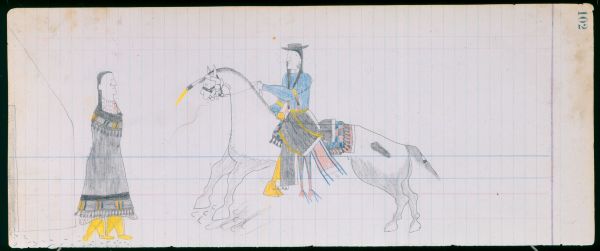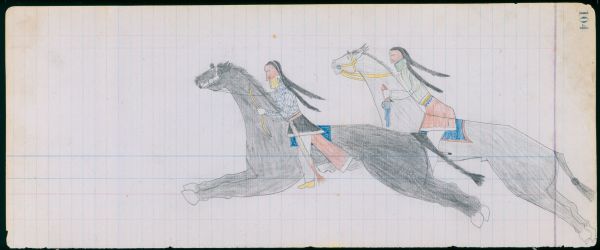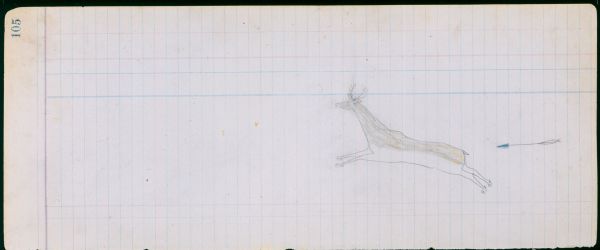PLATE 102
Ethnographic Notes
"In old times...no boy would ever have thought of throwing his arms around a girl. He waited for her, as she was going for wood or water, and as she passed him...whistled or called to her, to endeavor to get her to look at [him] in the hope that she would smile, or in [some] way encourage [him] to be a little bolder" (Grinnell, 1923, I: 132-33).
Arrow may be recognized here, from his white horse with the iron-grey legs and black hip spot, and from the signature feather tied in the horse's tail. His yellow vaquero saddle, and silver headstall have also been seen often before. The many hoofprints under the horse's feet indicate that Arrow and his mount have been standing there a long time, "champing at the bit", and waiting for the lady to appear. This is the same horse Arrow selected when he went to spy on his sweetheart in Plate 34. It is likely this is the same young lady depicted there: her yellow-painted boot-moccasins have the same narrow cuffs and vertical panels of white beadwork in both drawings. Here, she wears a striped calico dress, and a Chimayo blanket with black, fringed tassels.
Over his saddle Arrow has laid a similar Chimayo weaving folded into quarters; and atop this a folded, dark blue wool trade cloth blanket held on with a separate girth---compare Plates 32, 88 & 154. The folded, red wool blanket lies under the saddle, as a pad.
Around his waist Arrow has wrapped a double-width courting blanket, with the edges bound in yellow silk ribbon or cloth. A better view of this is given in Plate 34; and probably the same blanket is worn by Arrow's comrade in Plate 90. Arrow's distinctive red breechcloth, with its four stripes of blue silk ribbon, is the same one he wears in Plates 86, 94, 120 & 130. The breechcloth is secured with a sash of plaited red and blue yarn, the long ends hanging down beside his leg. Arrow's leggings are of undecorated dark blue (shown as black) wool trade cloth, as seen in many earlier drawings. The fully-beaded moccasins are slightly different than any shown elsewhere, with a white box within each dark triangle.
Arrow's shirt is probably of watered silk, with subtle, darker stripes over a blue ground. Brass armbands accent this garment. Arrow's hair is dressed very simply, merely divided into two queues, with the ends secured by a wrapping of red cloth. A dentalium shell choker, and silver, ball-and-cone earrings add to his outfit, while he is crowned with a porkpie hat of blue-dyed felt that sports a red-silk hatband.
The structure at left is one of the canvas wall tents which were being issued to some Cheyenne families by the early-1870's. A lot of these are shown in the "Little Chief" depiction of a Cheyenne Sun Dance encampment (National Museum of the American Indian, Cat. No. 11/1706---see Heth, 1992: Fig. 151). Generally, these tents were employed by larger families as adjunct-space for storage, and as spare rooms for sleeping, or entertaining.
The earliest-surviving photograph of a Southern Cheyenne woman, made in 1867 (see Cowdrey, 1999: Fig. 43), shows the lady wearing a striped-silk or calico dress very similar to the one which Arrow depicts here.


